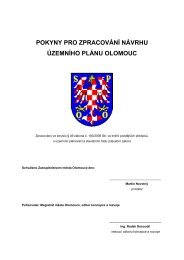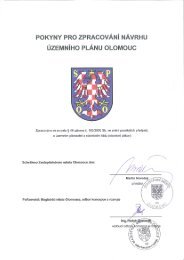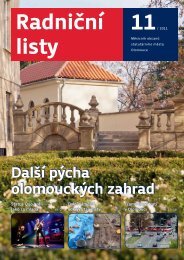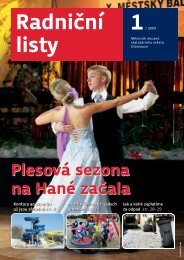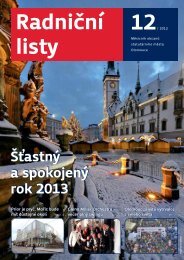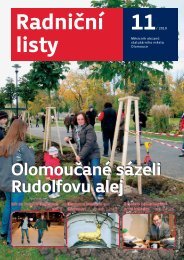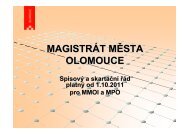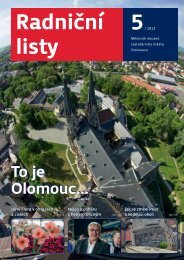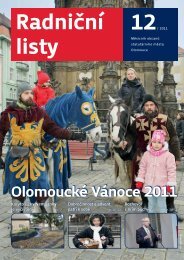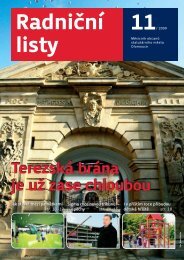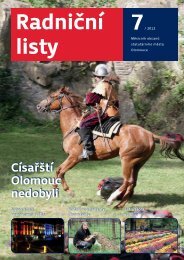Astronomical clock - Olomouc
Astronomical clock - Olomouc
Astronomical clock - Olomouc
You also want an ePaper? Increase the reach of your titles
YUMPU automatically turns print PDFs into web optimized ePapers that Google loves.
INFORMATION CENTRE OLOMOUC<br />
region<br />
Horní náměstí (Upper Square) – The Town Hall<br />
Opening hours: daily 9 am – 7 pm<br />
infocentrum@olomouc.eu<br />
Tel.: +420 585 513 385, +420 585 513 392, Fax: +420 585 220 843<br />
http://tourism.olomouc.eu<br />
IC <strong>Olomouc</strong> provides the following services:<br />
1. Tourist information and accommodation<br />
– tourist information about <strong>Olomouc</strong> and the environs<br />
– travel information<br />
– guide services<br />
– daily tours of the Town Hall tower at 11 am and 3 pm<br />
– tours of the Town Hall including entrance into the tower<br />
2. Information about cultural, social and sports events<br />
– advanced ticket sales for cultural events taking place in <strong>Olomouc</strong><br />
3. Sales of souvenirs and maps<br />
4. Information about the activities of the city government and other institutions<br />
within the territory of the city<br />
5. EUROPE DIRECT – European information centre<br />
the Czech republic<br />
region region region region<br />
Prague<br />
region<br />
<strong>Olomouc</strong><br />
Brno<br />
<strong>Olomouc</strong> Region<br />
region<br />
Ostrava<br />
London<br />
Paris<br />
Europe<br />
Berlin<br />
the Czech republic<br />
A tourism card<br />
that saves you money!<br />
A tourism card valid for 48 hours or 5 days, in <strong>Olomouc</strong>, in Central<br />
Moravia and Jeseníky:<br />
ADMISSION FREE: Castles, chateaux, museums, zoos,<br />
<strong>Olomouc</strong> city public transport, minigolf,<br />
adrenalin attractions and others<br />
DISCOUNTS: Aqua-parks, spa treatments, caves, restaurants,<br />
accommodation and others<br />
The card can be purchased at information centres and from other<br />
authorised sellers.<br />
More information at: www.olomoucregioncard.cz<br />
OLOMOUC region CARD<br />
The project was co-fi nanced using the funds of the <strong>Olomouc</strong> Region and the EU Structural Funds through<br />
the Common Regional Operational Programme.<br />
In the year 1800 the <strong>clock</strong> stopped, for eleven years, and<br />
soon after provisional repairs it stopped again, and remained<br />
so until the year 1898. At that time, at the peak of the boom<br />
of historicist style, the astronomical <strong>clock</strong> was given a Romantic<br />
façade, for the fi rst time seriously violating its artistic<br />
and technological originality. The fi rm of Eduard Korfhage<br />
gave it a new planetarium mechanism, based on the solarcentric<br />
planetary system. The painting and sculptural decorations<br />
were replaced with the handiwork of architect Robert<br />
Dammer, painter Richard Bitterlich, and woodcar vers Bernhardt<br />
Hoetger and Franz Celler.<br />
The fi nal negation of the astronomical <strong>clock</strong>’s lasting historical<br />
worth as an artistic monument was the intervention by<br />
Karel Svolinský during the years 1947–1955. This was preceded<br />
by the intentional destruction of the <strong>clock</strong> at the end<br />
of the Second World War, which however was not substantially<br />
more damaged than the astronomical <strong>clock</strong> in Prague. It is<br />
as if, in the middle of the grim 1950s, the cold pastoral idylls<br />
of a Russian children’s book shined down upon <strong>Olomouc</strong>’s<br />
(at that time named) “Stalin Square”, populated however by<br />
working, jubilant, athletic Haná locals. Although Svolinský<br />
had already in the time of his youth on nearby Svatý Kopeček<br />
been a master puppet carver, the job of making the moving<br />
fi gures was however given to his wife Marie. The job of making<br />
the glass mosaics with the subjects of the Ride of the<br />
Kings, Procession of Haná Beauties, the Worker, the Chemist,<br />
St. George and the Dragon (1898),<br />
Bernhardt Hoetger.<br />
Flight from Egypt (1898),<br />
Bernhardt Hoetger.<br />
Inauguration Celebration of the Neo-Gothic-style Astronomic Clock,<br />
22 May 1898 (by <strong>Olomouc</strong> photographer H. Schleif).<br />
and the Allegory of the Twelve Months was given by Svolinský<br />
to the Česká mozaika (Czech Mosaics) national enterprise in<br />
Nový Bor. The <strong>clock</strong> mechanism, the only part of the old <strong>clock</strong><br />
which was to be left in place, was repaired by the <strong>clock</strong>maker<br />
Konrad Schuster. Its new musical repertoire was prepared by<br />
Antonín Schindler and Josef Harna – today, thanks to them,<br />
the <strong>clock</strong> plays the Haná hymns “On the Hill beyond Náměšť,”<br />
“The Long and Winding Road to <strong>Olomouc</strong>,” and “The Willows<br />
Are in Bloom”.<br />
In 1990, after the removal of the <strong>Olomouc</strong> monuments<br />
to Jo seph Stalin and Czech communist Klement Gottwald,<br />
came a question of legal precedent as to whether it would be<br />
possible to return the astronomical <strong>clock</strong> to a dignifi ed appearance.<br />
Discussion was tabled at the very outset when the<br />
local Monuments Institution absolutely refused to consider<br />
the astronomical <strong>clock</strong> as a monument. Today the question<br />
is rather concerned with the consequence of the other fact:<br />
that Svolinský’s work, in its own way, bears witness to a time<br />
which it would be advisable not to forget.<br />
Text: Marek Perůtka<br />
Photos: <strong>Olomouc</strong> Town Archives, <strong>Olomouc</strong> Natural History<br />
Museum, State District Archive in <strong>Olomouc</strong><br />
<strong>Astronomical</strong> <strong>clock</strong>
ASTRONOMICAL CLOCK<br />
The celebrated <strong>Olomouc</strong> <strong>Astronomical</strong> Clock is a major component<br />
of the northern façade of the Town Hall. It is set into<br />
a lancet arched bay recess which reaches the not unsubstantial<br />
height of nearly fourteen metres. Its current face,<br />
a curiosity in the style of socialist realism, bears no witness<br />
to its long history, its scientifi c qualities, nor to the richness<br />
of the moving fi gures which once accompanied its music<br />
and its charms. Thankfully, archival sources and museum<br />
collections can tell the story of how the astronomical <strong>clock</strong><br />
has fascinated people since the fi fteenth century.<br />
Local legend connects its origin to the years 1419–1422.<br />
Sun indicator<br />
on the astronomic dial<br />
(1573–1575).<br />
Planisphere by Pavel Fabricius<br />
(1573–1575).<br />
Baroque indicator of the<br />
phases of the moon (1746).<br />
Moon indicator<br />
on the astronomic dial<br />
(1573–1575).<br />
Modern research on the process of the Olo mouc Town Hall<br />
construction puts the origin of the astronomical <strong>clock</strong> alcove<br />
in conjunction with extension of the late-Gothic reconstruction<br />
which began in 1474, but the fi rst certain record of its existence<br />
dates from 1519. The original <strong>clock</strong> (the appearance<br />
of its face is unknown) was “renewed and improved” during<br />
the fi rst large-scale renovations in the years 1573–1575.<br />
Participating Pozdně in gotická this project kroužená were klen- a man of letters (an astronomer<br />
– the ba eminent presbytáře Vienna v radniční University kapli. professor and personal<br />
astrologer to Emperor Maximillian II, Pavel Fabricius) and a<br />
craftsman (a <strong>clock</strong> maker – <strong>Olomouc</strong> <strong>clock</strong>maker Hans Pohl).<br />
The astronomical <strong>clock</strong> at that time was a visual demonstration<br />
of the medieval scheme of the universe, housed in the<br />
form of a gothic winged shrine with sculptures and paintings.<br />
It contained fi gures which mov ed in time to musical and<br />
percussive mechanisms, and featured paintings on woo den<br />
panels. The universe was depicted as having three spheres:<br />
the lowermost being the calendar dial (earthly sphere), above<br />
this the astronomical/astrological dial (celestial sphere), and<br />
above that sculptures of cherubim with tiny hammers which<br />
beat upon a carillon (the heavenly sphere).<br />
The Thirty Years’ War affected the astronomical <strong>clock</strong> as it<br />
did the rest of the city. The job of its next rebuilding, in the<br />
years 1661–1662, was taken up by the mechanic Martin<br />
Kelbl, the <strong>clock</strong>maker František Jahn, and Antonín Gerhard<br />
– a Jesuit, mathematician, and expert in things astronomical.<br />
At that time renovations concerned with enriching the paint-<br />
ing elements of the <strong>clock</strong> concentrated on murals depicting<br />
the Seven Liberal Arts on the interior surfaces of the arch.<br />
The lower part of the <strong>clock</strong> still contained Fabricius’s indicating<br />
dials with four smaller indicators on the sides. Their<br />
dials indicated the quarters, hours, planets and red-letter<br />
days and “non-equal” hours. The day of the year was indicated<br />
by an angel on the lower calendar dial. In the central<br />
portion of the <strong>clock</strong> was the carillon, above which was<br />
a royal portrait and at the same level a reclining sculpture<br />
of the goddess Luna. The side “wings” of the <strong>clock</strong> were<br />
animat ed by a set of mechanical marionettes. On the left<br />
was St. Wenceslas, around whom St. George on horseback<br />
pursued a retreating dragon. Above them, while the hours<br />
were rung, a monk fi ngered a rosary and an anchorite<br />
pulled a bell-rope. The right side portrayed the Madonna<br />
and Child below, circled and adored by the Three Magi.<br />
Above this group was a Renaissance cavalier performing<br />
the function of a bell-ringer, accompanied by a trumpeter.<br />
The last major renovation of the astronomical <strong>clock</strong> in its<br />
original form (based on its conviction that the sun and<br />
planets revolved around the Earth) occurred in the years<br />
1746–1747. Again a <strong>clock</strong>maker and organmaker came<br />
into play, as well as the most famous painter to work on<br />
the astronomical <strong>clock</strong> to this day, the <strong>Olomouc</strong> Baroque<br />
painter Jan Kryštof Handke. For his paintings for the interior<br />
faces of the alcove walls, Handke kept to the motif of the<br />
Moving Renaissance<br />
bell-ringer fi gure<br />
(1573–1575).<br />
“Depiction of the artistic <strong>clock</strong> of <strong>Olomouc</strong> Town Hall at its fi nest<br />
condition in the year 1747”. Watercolour by J. W. Fischer (1805).<br />
Seven Liberal Arts, a choice deferring to the celebration<br />
of the natural sciences – Arithmetic, Geometry, Astronomy,<br />
and Music. Belonging to these are also Grammar, Rhetoric,<br />
and Logic. Handke added a fi nal allegory to these to make<br />
a round eight – Industry, the essential condition for success<br />
in any fi eld. Below on the frontal portion Handke (with great<br />
self-confi dence) painted a <strong>clock</strong>maker and a painter as the<br />
two main fi gures, which can be considered accurate depictions<br />
of the two masters themselves.



